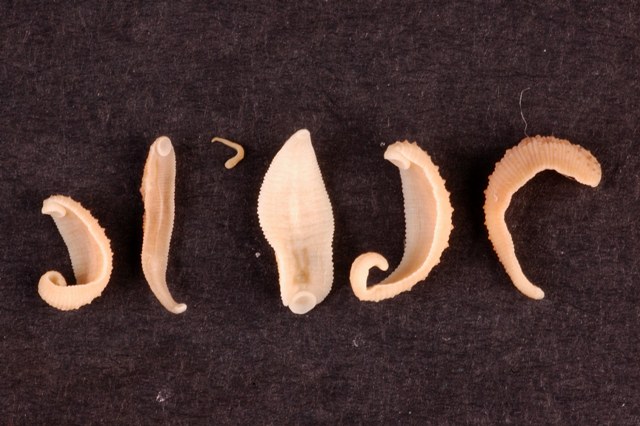Phylum Annelida
Class Clitellata
Order Rhynchobdellida
Common names: freshwater leeches, jawless leeches
Overview
Rhynchobdellida are aquatic leeches characterised by a protrusible proboscis that is used to feed on the blood of amphibians, reptiles, birds and fish. They are characteristically oval-shaped, narrower anteriorly and convex above. The head is narrowly rounded with a shallow open ventral sucker with small circular pore-like mouth in the centre or near the anterior through which pharynx can be everted as a proboscis. They range in length from 7 - 40 mm. The Glossiphoniidae are predacious and sanguiviorous freshwater leeches with a flattened, pear-shaped body and a poorly defined anterior sucker. The Piscicolidae are marine, have more cylindrical bodies, and a usually well-defined, bell-shaped, anterior sucker. The Ozobranchidae occur in sea and freshwater and are not unanimously accepted as a distinct family, often being considered part of the Piscicolidae. Members of this family typically have digitiform branchae along the margins of the body and may have lateral projections or 'gills'. Most rhynchobdellids can swim by flattening their body and using dorsoventral undulations of the body. Some species of Glossiphoniidae and Ozobranchidae can swim only as juveniles not as adults. Others �loop� along using their suckers.
Distribution and diversity
Worldwide, two or three families are recognised: the freshwater Glossiphoniidae (25 genera, 208 species); Pisicolidae (17 freshwater genera with 57 species; also 100 marine species); and Ozobranchidae: (2 genera, 7 freshwater and 2 marine species). The Ozobranchidae is not universally accepted as a distinct family, often being merged with the Piscicolidae. In Australia, two families have freshwater representatives. Glossiphoniidae has four genera with 10 species found in freshwater creeks, rivers, lakes and pools across New South Wales, South Australia, Tasmania, Victoria, Queensland and Western Australia. Ozobranchidae is represented by a single species, Bogabdella diversa, which occurs in fresh and saltwater habitats across New South Wales, Victoria and Western Australia.
Life cycle
Rhynchobdellida are sexually reproducing hermaphrodites, with some species producing sperm and eggs at the same time, while others are protandrous hermaphrodites, first functioning as a male producing sperm and then as a female for egg production. Like oligochaetes, rhynchobdellids lay their eggs in a chitinous cocoon formed by the clitellum that is buried in the substrate or attached to submerged rocks, logs or plants. Development is direct with juveniles growing continuously till adulthood. Many species of Glossiphoniidae display high levels of parental care with cocoons remaining attached to the ventral surface of the parent to protect and care for the young as they develop, including providing food for the young leeches who remain attached to the parent�s ventral surface after they hatch.
Feeding
There are both sanguivorous and predacious species of Rhynchobdellida. Sanguivorous species are temporary ectoparasites that use a protrusible proboscis to penetrate the host's skin and feed on amphibians, reptiles, water birds and fish with a few species feeding on mammals. Most are not host specific. Their saliva contains anticoagulants to promote blood flow and an anesthetic that allows leeches to complete feeding without detection. At least some glossiphoniids are known to have symbiotic bacteria in the esophagus that aid in digestion. Predacious species also use a protrusible proboscis to attack a range of prey including oligochaetes, amphipods, insect larvae and molluscs. Most are �sit-and-wait� predators that use their anterior sucker to catch and subdue prey, however some Glossiphoniidae species actively seek prey using chemo- or mechano-reception. They swallow prey organisms whole or in pieces and secrete digestive enzymes to break down the fluids and tissues of their prey.
Ecology
Rhynchobdellida occur in both lotic (running water) or lentic (standing water) habitats including creeks, rivers, lakes, swamps and ponds. They are found on the muddy or silt bottom, the underside of stones and amongst vegetation or attached to aquatic vertebrates. Predacious species are often found attached to submerged objects such as wood, stones and aquatic vegetation waiting for their prey. They are usually nocturnal and often cryptically coloured. In general, leeches can tolerate a broad range of salinities, temperatures, and oxygen concentrations.

Helobdella papillornata with cocoons
Image credit: unknown








